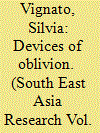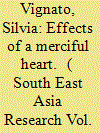|
|
|
Sort Order |
|
|
|
Items / Page
|
|
|
|
|
|
|
| Srl | Item |
| 1 |
ID:
113279


|
|
|
|
|
| Publication |
2012.
|
| Summary/Abstract |
Since the peace agreement has put an end to the 30-year-long civil conflict in the province of Aceh in Indonesia, poverty, parental loss, lack of opportunities and an old tradition have caused a growing number of Acehnese girls and boys to spend between three and ten years in residential Koranic schools [dayah or pesantren]. There, they process their experience of the conflict, be it direct or indirect. In this article, thanks to ethnographical data, the author explores this labour of transformation. An idea of resilience which is culturally based in local societies is analysed. Key issues are the difference between personal and social resilience, plus the transformations that a resilient process enhances in the very culture from which it stems. The dayah have proved very effective structures in facing the needs of the poorest Acehnese children. Nevertheless, the author argues, they tend to shape the children according to a general model that can create exclusion and crystallize pre-existing psychic suffering. This paper indicates that different visions of trauma and memory characterize different parts of the same society, and that selecting one or another is a political choice that is embedded in international policies.
|
|
|
|
|
|
|
|
|
|
|
|
|
|
|
|
| 2 |
ID:
158206


|
|
|
|
|
| Summary/Abstract |
In this article, I examine the relationship of charitable help that, through the persons and the work of caregivers, connects some donors to the young persons who grow up in home-based childcare institutions in contemporary Malaysia. The prism of my analysis is the small charity functions that take place within the homes that I have studied, which allow donors and receivers to elaborate, perfect and enact moral ideas of themselves and of their place in society. Because they stage the main characters of charity, the functions also give an insight into how, since an early age, children actively explore the dominant and largely ethnicized model of virtue and merit they are summoned to embody, thus making sense of their shared condition of “charity children”. This self-care work, I argue, inspired by Erica Bornstein’s study on Indian charity, is made possible by the “pure gift” core that characterizes donors and caretakers, as it frees the aided children from the necessity to “buy” their care back, which is otherwise requested in traditional child fostering.
|
|
|
|
|
|
|
|
|
|
|
|
|
|
|
|
| 3 |
ID:
128881


|
|
|
|
|
| Publication |
2013.
|
| Summary/Abstract |
This Special Focus is the second part of 'Life after collective death in South East Asia', a collection of papers examining what happens after wide-scale destruction has occurred and how the social and individual lives of the survivors recover. Part 1, published in South East Asia Research in June 2012 (Vol 20, No 2), focused on the social and religious processes that help the '(re-)fabrication of social bonds'. Part 2 deals with another major aspect of resilience - the issue of help, especially in the case of international humanitarian aid. In many ways, in the contemporary situation, it is taken for granted that help will be provided. We question the evidence for this, asking what rationales are involved in post-catastrophe help. We shed light on why, for example, people decide to engage in non-governmental organizations (NGOs) to help distribute drugs in a Cambodian outpatients ward or, alternatively, to carry rice sacks in the Ayeyarwady Delta to help victims of the typhoon in Myanmar. We highlight why people in the West consider such activities 'normal'. We focus on how people, having been labelled as 'victims', receive and perceive such aid and how they respond to it. Further, we ask how (and to what extent) aid contributes to change, implicitly or explicitly, in the societies affected. Finally, we question what contemporary international aid brings when compared to the older local relief systems and systems of mutual help, particularly those examined in Part 1.
|
|
|
|
|
|
|
|
|
|
|
|
|
|
|
|
|
|
|
|
|